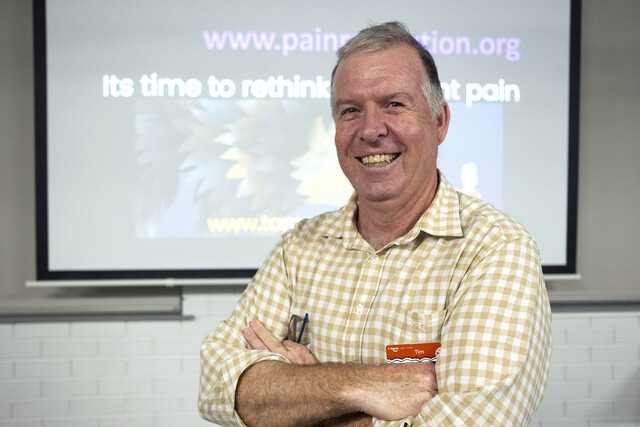When it comes to persistent pain, pain that continues for more than three months, modern pain science is replacing the long held bio-medical view that pain indicates damage, to a more complex concept that pain is a protector of the body that can even hinder recovery.
A physiotherapist for 30 years Tim Bagshaw spoke to attendees, many with persistent pain, at Noosa U3A last Friday to say the modern view of pain had changed drastically over the past 5-10 years due to a growing body of research.
Mr Bagshaw works with the Sunshine Coast Persistent Pain Service which operates at Nambour Hospital and has outreach services to Gympie, Maleny and Caloundra. He has run a private practice in Maleny for 25 years and is involved in a group called Pain Revolution, a not for profit organisation whose vision is for all Australians to have the knowledge, skills and local support to prevent and overcome persistent pain.
“How we perceive things depends on the meaning we give to it,“ he said.
“We were taught if you stick a pin in your toe the pain receptor in your toe sends a pain message through your spinal cord relay to the pain centre in your brain – you’ve got pain. We were taught pain is a detector of damage, he said.
“The modern view is that pain is complicated. The brain is constantly judging threat and risk to calculate pain. Pain protects us from damage. Persistent pain overprotects us and prevents recovery.“
He gave an example of one study in which participants received a laser shot on their feet. They expected to receive an electric charge. People who were told the procedure was “probably safe“ experienced more pain from it than the people who were told it was “safe“. There was no electric charge.
“We know past experience and language can influence pain,“ Tim said.
“We think of pain as protector. It stops you from going too close to a fire, stops you from sitting too much.
“You need that pain to protect you.
“We should be asking what is pain protecting. It can change from moment to moment as the brain is judging that level of threat.
“If you’re doing something you enjoy pain is not that bad. If you’re really stressed pain gets worse. Your brain is protecting you from the situation.
“Persistent pain overprotects us and prevents recovery.
“We have a pain production system. Our body learns pain. We get better at producing pain the longer it gets on.
“There are potential drivers of pain all over that pain production system. It can give us pain production hypersensitivity. The pain system is turned up. It’s overprotecting us, stopping doing what can help our pain.“
Tim said learning about pain helps with pain.
“A study done in Adelaide a few years ago with more than 800 persistent pain participants gave them 12 months of pain education, about 50 hours.
At the start of the study they had a pain average of 5 out of 10, which is significant. Those who understood about pain at the end of the study had a pain average of about 1 out of 10, he said.
Lots of things can influence pain, including your biology, genetics, psychology, social activities and cultural beliefs, Tim said.
“What we eat and drink, sleep, stress, past experience, friends and family, things you do to cope, hobbies and activities, emotions, strength and fitness, general health. They can all influence each other,“ he said.
“There’s no one thing to switch your pain off.
“If we work on all those things the net effect will influence pain.“
Tim said he believed the pain patients feel is real but the good news was it was “changeable“ though may require you to think differently.
“You have to trust your bodies again. Work on what you think. Do fun stuff,“ he said
“We are capable of improving. The modern view is there are many ways to reduce pain.
“Our bodies are amazing at healing given a chance.“







